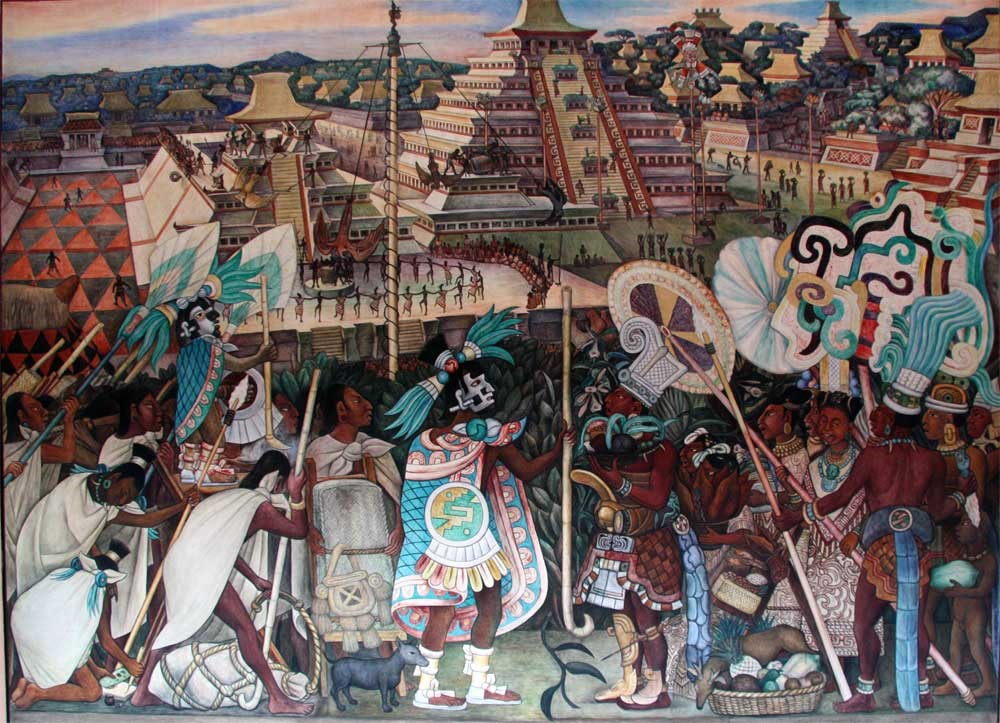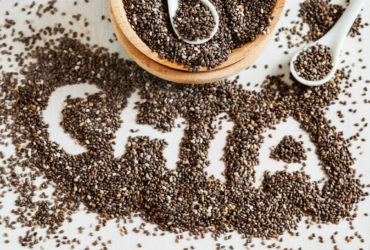By Bryan Quoc Le | 150 Food Science Questions Answered
The Legend of Vanilla
According to old legends told by the indigenous Totonac “Jaguar” people of Mexico, in a time before vanilla was cultivated, there lived the beautiful princess Tzacopontziza of the Totonocopan kingdom [1]. One day, a young prince by the name of Zkatan-Oxga saw her picking flowers for a temple offering, and overcome with passion, he whisked her away into the depths of the lush forest. But before they reached their destination, they were stopped by the temple priests, and executed on the spot for their transgressions. After several months, the tendrils of a young, fragile green vine grew from the spot on which the two had been executed and grew many feet tall in a few days. From the vine came green pods that opened and released a fragrant scent that perfumed the entire rainforest. The legend identifies vanilla as the plant that grew on the grave of the beautiful princess. It was from the death of the beautiful princess that gave birth to vanilla.

“Totonac Civilization, El Tajin”, 1950 by Diego Rivera. Photo courtesy of Mary Ann Sullivan at Bluffton University, 2010.
While the myth of Tzacopontziza is but one of many stories that riddle the oral histories of the Totonac Indians about the origin of vanilla, the Totonacas all agree that the fruit of the Tlilxochitl vine, the vanilla pod, was an incredible gift bestowed upon their tribe. Tantalizing yet delicate, the flavor and aromas of vanilla have been prized by the Totonac natives for generations, and the pods of the vanilla plant continued to be cultivated by the Totonaca people until the 19th century. During the 15th century, the Aztecs developed a taste for vanilla after conquering the Totonocopan region, forcing the Totonacas to pay tribute with their vanilla pods. The Aztecs were fond of a drink that combined cocoa beans with vanilla (chocolatl), which we now know as a predecessor to hot chocolate. The taste of vanilla expanded to Europe after the Spanish conquered the Aztecs and brought back the chocolatl drink to Spain. After its arrival in Europe, Queen Elizabeth I’s royal apothecary – Hugh Morgan –transformed vanilla from an additive to chocolate to a flavoring in its own right, and vanilla became a court favorite. [2].
Birth of an Industrial Flavor
Once vanilla made its way into the gustatory consciousness of the Western world, the uses for vanilla began to expand exponentially. Demand for vanilla continued to rise as vanilla appeared in recipes for confections, pastries, beverages, candies, and ice cream. Vanilla became and continues to be one of the most important flavoring agents in the world. However, the places in which the vanilla orchid can thrive and bear fruit are primarily localized in the tropical regions of the world that are subject to tumultuous environmental conditions such as rainstorms, deforestation, and fluctuating harvests. The most commercially significant of these production areas were Mexico, Tahiti, the West Indies, and Madagascar. On top of that, vanilla harvesting methods were labor intensive, requiring laborers to manually pollinate the orchid flowers prior to fruiting as well as collect mature vanilla pods every day, as each pod ripens at its own pace [3]. These factors together were largely responsible for the high cost of vanilla, making natural vanilla the second most expensive flavor in the world, behind saffron. Saffron, similarly, is expensive because of the extreme levels of labor that goes into harvesting the flower.
The high cost of natural vanilla harvesting created a push for alternative sources of vanilla flavor and became the impetus for manufacturing synthetic vanilla. In 1858, French pharmacist Nicolas-Theodore Gobley isolated pure vanillin crystals from the extracts of vanilla bean and determined vanillin to be the principle flavor compound found in vanilla [4]. Two enterprising German chemists, Ferdinand Tiemann and Wilhelm Haarmann, followed suit and deduced the chemical structure of vanillin, allowing them to conduct the first synthesis of vanillin using a readily available glucoside of isoeugenol, coniferin, a product of pine tree sap [5]. Vanillin is prepared by first oxidizing coniferin (1) to cleave the hydroxyl substituent and give glucovanillin (2), followed by cleavage of the sugar glucoside to give the desired phenol characteristic of vanillin (3).

Together, they started a vanillin production plant to commercialize this process, but surprisingly did not achieve financial success. Within in a few short years after opening, Karl Reimer and Ferdinand Tiemann devised a second synthesis of vanillin by utilizing guaiacol, a less expensive product of wood and coal pyrolysis, and subjecting it to the action of warm chloroform and alkali to install an aldehyde group on the molecule, followed by an acidification step to produce vanillin as the final product. Now known as the Reimer-Tiemann reaction for the preparation of phenolic aldehydes [6], the synthesis became commercially successful and led to the formation of the Harmann & Reimer Company, one of the corporate predecessors of the flavor powerhouse now known as Symrise.

“Gravel Yards”, 1934 by Gregory Orloff. Courtesy of the Smithsonian American Art Museum.
With a new commercial production process, and accompanying lower price, uses for vanilla flavor spread like wild fire. The low cost afforded by the new method of vanillin synthesis led to mass production of many popular treats, confections, baked goods, sweets, and drinks (alcoholic and otherwise), normally reserved for the wealthy upper class. At one point, vanilla made its way into the age-old frozen dessert, ice cream, popularized in the United States by Thomas Jefferson, himself [7]. Vanilla also found use in the perfumery industry as a base note, where its unique ability to enhance sweet scents and round out stronger notes became an important feature, exemplified by the strong, oriental vanillin notes of Guerlain’s Shalimar perfume of 1925. The changing economic landscape around vanilla also created a new opportunity for food entrepreneurs. In 1886, Coca-Cola arrived on the market, whose original formula called for the use of vanilla, and vanilla flavor production rose to meet the new escalating demand [8]. The economic future of the vanilla enterprise seemed secured.
The Evolution of Synthetic Vanilla
The growing vanilla industry expanded efforts to develop new methods in the synthesis of vanillin and continued driving down costs. Clove oil became an important feedstock for vanillin synthesis after another pathway was discovered and the reduced cost of clove oil at the time made the method economical. The main component of clove oil, eugenol, is structurally similar to coniferin and the same approach is taken to convert the eugenol to vanillin. The clove oil process eventually fell out of favor by the 1920s after low-cost synthetic guaiacol became available following the meteoric rise of the petrochemical industry. A more efficient pure petrochemical process of vanillin synthesis was developed in the 1970s by Solvay and in current use commercially. Here, guaiacol is first reacted with another petrochemical product, glyoxylic acid, to form vanillylmandelic acid. This intermediate is acidified and oxidized by atmospheric oxygen to form vanillin.

Synthesis of Vanillin, from https://chempics.wordpress.com/tag/vanilla/. Accessed October 30, 2017.
Another method of vanilla production uses lignin as a substrate, an abundant biopolymer found in wood and a byproduct of wood processing. By oxidizing the lignin with sodium hydroxide and sodium sulfide, vanillin is easily synthesized [9]. Unfortunately, the product is not approved for food use due to the toxic copper reagents used to affect the catalytic oxidation process. The vanillin produced here is used mostly for perfumes and as a reagent in the production of pharmaceuticals.
Ethylvanillin is another synthetic variant that was eventually discovered to have a stronger flavor than vanillin itself, and has been used since the 1930s due to its desirable flavor performance and ability to withstand the high temperatures of baking [10]. A minor byproduct of the guaiacol process, ethylvanillin differs from vanillin in that the vanillin molecule contains a one-carbon methyl-substituent; replacing it with the two-carbon ethyl group gives ethylvanillin. While three to five times stronger in flavor intensity than vanillin, ethylvanillin is much more expensive and only reserved for select applications such as high quality chocolates or baked goods. But the flavors of ethylvanillin and vanillin aren’t not additive, so the two compounds can be added together to give a richer, deeper mimic of vanilla flavor without suppressing one another.
Vanilla of Today and Tomorrow
Currently, annual vanillin production reaches about 18,000 metric tons with 85% of the world’s vanillin produced using the guaiacol method, while the remaining 15% is made from lignin [11]. Madagascar and Indonesia represent the largest contributors of natural vanilla with a combined output of 6,300 metric tons [12]. Vanilla production continues to grow with expanding food markets, with vanilla not only incorporated in strictly vanilla or chocolate-flavored products, but also fabricated foods with any flavor that requires the addition of a pleasant, smooth, creamy-sweet aroma to round out the desired flavor. Indeed, the vanilla aroma is so unique and important in flavor formulation that it represents its own individual class within flavorist circles.
The current industry trend for flavor and food companies has been to move away from synthetic vanillin in favor of natural vanilla. Driven by consumer demand for the all-natural label, the demand for vanilla bean has led to several food companies, including Nestle, General Mills, Hershey’s, and Kellogg’s, to adopt natural vanilla for their products. The great challenge in the transition is the small global output of natural vanilla, leaving many flavor houses to contend with high prices and an uncertain supply. Flavorists and food producers have been forced to reformulate their products to adjust their concentrations of vanillin in response to the changing market landscape.
Biotechnology companies Evolva and Ginkgo Bioworks are approaching the natural vanilla flavor challenge from another angle. Using gene-editing methods to introduce biosynthetic genes into the genome of yeast cells, they are producing vanillin from these designer microbes by fermenting cheap and widely available sugar feedstocks. Because the flavor compounds are produced by living organisms, and not synthesized using chemical precursors, the vanillin could potentially be labeled as natural, rather than artificial, under current regulations. This synthetic biology, or synbio, approach may become important in building a sustainable and reliable pipeline of natural vanilla, compared to the volatile supply of natural vanilla derived from grown seedpods. However, consumer fears about genetically modified organisms such as this and their products may push these firms to redirect their efforts [13].

Vanilla Study II, by Helen R. Klebesadel. From Etsy, https://www.etsy.com/listing/63427253/vanilla-study-ii-an-original-watercolor. Accessed October 30, 2017.
A Lingering Flavor
Riding on the Spanish galleons across the Atlantic Ocean to the royal palaces of the Old World, meekly hitched to its tropical cousin, cacao, in a minor role as a flavor enhancer for hot chocolate, vanilla landed in Europe poised to take the limelight. After the discovery of its self-possessed flavor uncoupled to cocoa, vanilla took the European nobility by storm and became a spice fit only for the aristocracy. In time, this exotic, classy flavor trickled down to through the culinary pipeline to the masses, still only reserved for holiday occasions and special treats. But vanilla became so tempting, so alluring, that it was to become one of the first synthetic flavors of the Industrial Revolution, which led to its widespread dissemination across the world. Now found in nearly every confectionary treat, sweet beverage, and sugary baked goods, vanilla has crossed over into the realm of cheap commodity items that any person can enjoy. And in our modern era of biotechnology and genetic engineering, vanilla is once again positioned to be one of the flavors to benefit from the next impending revolution in synthetic biology, and further spread its reaches into new growing markets, cultures, and appetites. While today, the word vanilla has been lumped together with the terms boring and derivative – with the possible exception of Vanilla Ice – vanilla has been center stage in the human drama of failing empires, rising industries, and technological revolutions, and will continue to star as a flavorful feature in both our childhood memories of sweet treats and our everyday enjoyment of foods far into the future.
As we can see, there was nothing ever ‘vanilla’, about vanilla.
Want to keep up with the conversation? Follow us on Instagram and Facebook for quick updates on seminars, events, and food science!
References
[1] Ecott, Tim. Vanilla: Travels in search of the ice cream orchid. Grove Press, 2005.
[2] Rupp, Rebecca. “The History of Vanilla.” National Geographic: The Plate, 23 Oct. 2014, http://theplate.nationalgeographic.com/2014/10/23/plain-vanilla. Accessed 15, Sept. 2017.
[3] “Vanilla Fun Facts.” Rodelle, http://rodellekitchen.com/learn-vanilla-baking/vanilla-fun-facts. Accessed 29 Oct. 2017.
[4] “Molecule of the Week: Vanillin” American Chemical Society, 12 Sept. 2016, https://www.acs.org/content/acs/en/molecule-of-the-week/archive/v/vanillin.html. Accessed 29, Oct. 2017.
[5] Maarse, Henk. Volatile compounds in foods and beverages. Vol. 44. CRC press, 1991.
[6] Li, Jie Jack. “Reimer-Tiemann reaction.” Name Reactions: A Collection of Detailed Reaction Mechanisms (2006): 492-493.
[7] Jefferson, Thomas. Library of Congress, Washington D.C. http://www.loc.gov/exhibits/treasures/images/uc004810.jpg. Accessed 29 Oct. 2017.
[8] Eplett, Layla. “Attempting the “Original” Coca-Cola Formula.” Scientific American: Food Matters, 27 July 2015, https://blogs.scientificamerican.com/food-matters/i-d-like-to-make-the-world-a-coke-attempting-the-original-coca-cola-formula/. Accessed 29 Oct. 2017.
[9] Pearl, Irwin A. “Vanillin from lignin materials.” Journal of the American Chemical Society 64.6 (1942): 1429-1431.
[10] Kennedy, C. Rose. “The Flavor Rundown: Natural vs. Artificial Flavors.” Harvard University: Science in the News, 21 Sept. 2015, http://sitn.hms.harvard.edu/flash/2015/the-flavor-rundown-natural-vs-artificial-flavors/. Accessed 29 Oct. 2017.
[11] Bomgardner, Melody M. “The problem with vanilla.” Chemical & Engineering News, 12 Sept. 2016. https://cen.acs.org/articles/94/i36/problem-vanilla.html. Accessed 29 Oct. 2017.
[12] “The Leading Countries in Vanilla Production in the World.” World Atlas: Economics, 25 April, 2017, http://www.worldatlas.com/articles/the-leading-countries-in-vanilla-production-in-the-world.html. Accessed 29 Oct. 2017.
[13] “Hayden, Erica Check. “Synthetic-biology firms shift focus.” Nature News, 29 Jan. 2014. https://www.nature.com/news/synthetic-biology-firms-shift-focus-1.14602. Accessed 29 Oct. 2017.

Bryan Quoc Le | 150 Food Science Questions Answered
IFTSA VP of Digital and Social Media (2019-2020)
Bryan is the author of 150 Food Science Questions Answered (Rockridge Press, 2020) and a Ph.D. candidate in Food Science at University of Wisconsin-Madison studying the health effects of garlic and onion flavors. He received his B.S. and M.S. in Chemistry at the University of California, Irvine. In another life, he walked 2,000 miles from California to Louisiana in six months, and learned that eating tuna and peanut butter every day was not meant for the average human body. After he met his wife, he learned that there was more to good food than canned goods and smoothies. While not juicing onions and pressing garlic, Bryan likes to run half-marathons, discover interesting cuisines with his wife, and help entrepreneurs develop great food products.






Leave a Reply